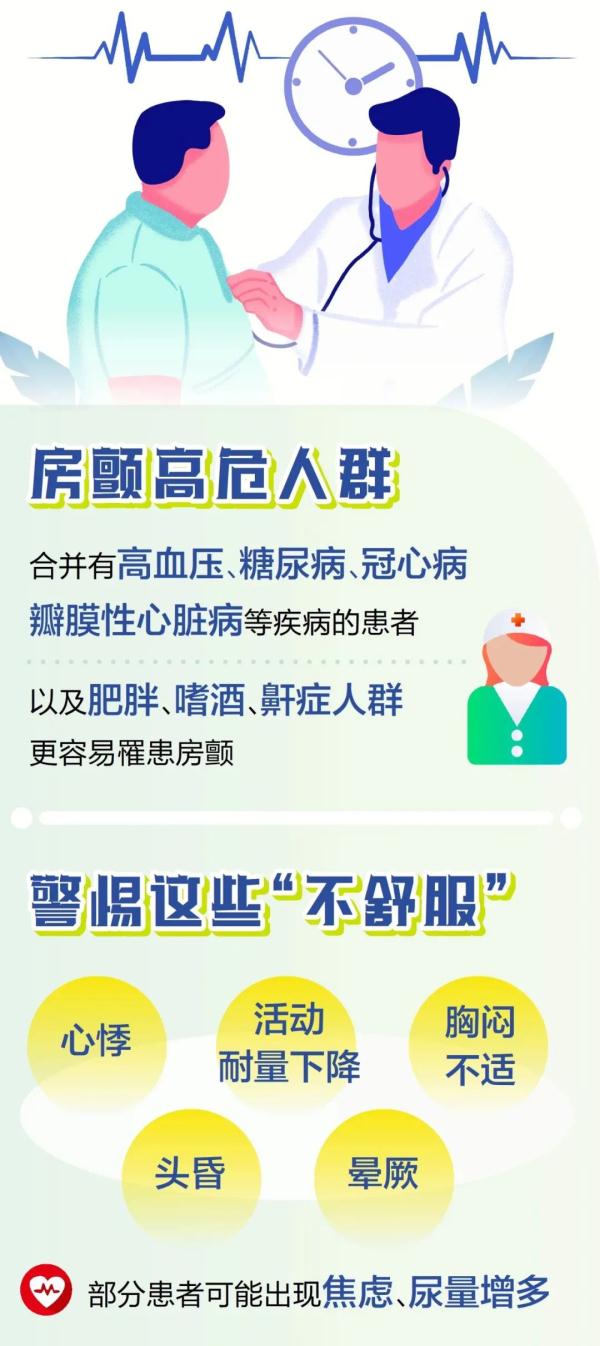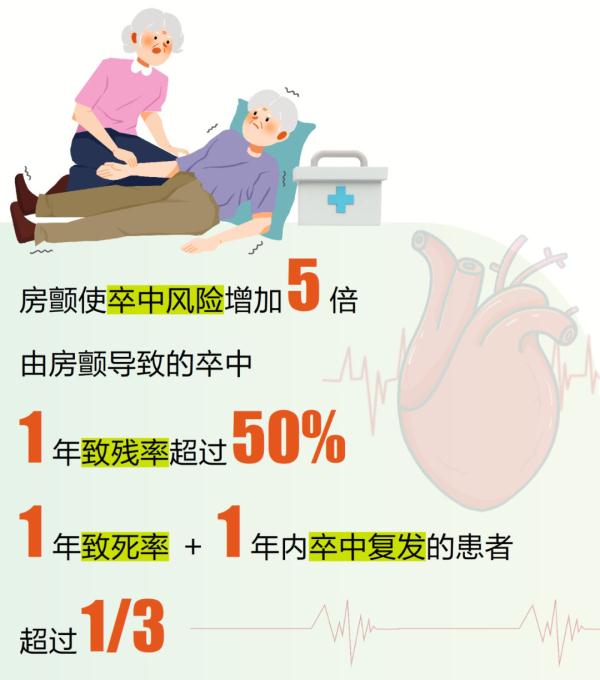Heart thumping? Be alert! These discomforts may be dangerous signals.
# Atrial fibrillation #
It is one of the high-incidence diseases in the elderly population.
Because the onset is often asymptomatic
Easily overlooked.
Also known as the "invisible killer" of elderly health.
Doctor’s reminder
Atrial fibrillation increases stroke risk fivefold.
Compared with long-term hypertension,
Stroke caused by atherosclerosis
Stroke caused by atrial fibrillation
It is often caught off guard and more harmful.
one
Heart thumping?
Pay attention to these "warning signs"
Atrial fibrillation, referred to as atrial fibrillation, is one of the most common types of arrhythmia. When atrial fibrillation occurs, the atrium vibrates irregularly and cannot contract and relax normally, resulting in a very irregular and irregular heartbeat. If you feel your heart pounding, you may have atrial fibrillation.
"In terms of symptoms, the manifestations of atrial fibrillation are diverse." Guo Zhuli, the attending physician of Cardiovascular Department of Yichang Central People’s Hospital, said that many patients with atrial fibrillation will show symptoms such as palpitation, decreased activity tolerance, chest tightness and discomfort, and may also show dizziness or even syncope. Some patients with long-term atrial fibrillation may also have anxiety and other problems. Some patients with paroxysmal atrial fibrillation may also have an increase in urine volume when they attack, because the secretory function in the atrium will activate the diuretic components when atrial fibrillation attacks.

Wang Yan, chief physician of tongji hospital Cardiovascular Department affiliated to Huazhong University of Science and Technology, reminded that patients with hypertension, diabetes, coronary heart disease, valvular heart disease, obesity, alcoholism and snoring are more likely to suffer from atrial fibrillation.
These high-risk groups need to pay special attention to the above symptoms. Once similar symptoms occur, it is recommended to go to the hospital as soon as possible and have an ECG examination to determine whether it is atrial fibrillation. In addition, people with conditions can also use smart wearable devices to monitor the heart in real time and accurately screen atrial fibrillation.
Because some patients with atrial fibrillation have no obvious symptoms, middle-aged and elderly people, especially those with the above risk factors, can have regular physical examinations or dynamic electrocardiogram every year.
For people with stroke, it is suggested to do more long-term electrocardiogram or screen atrial fibrillation with wearable equipment to rule out the possibility of stroke caused by atrial fibrillation.
2
Seven deadly sins of atrial fibrillation
It makes the risk of stroke five times higher.
There are "seven deadly sins" in atrial fibrillation, namely, stroke and other embolic events, heart failure, cognitive impairment, depression, impact on quality of life, repeated hospitalization and death.
Among them, stroke is one of the most serious consequences of atrial fibrillation. Tremor is prone to thrombosis. Once the thrombus falls off, it will flow with the blood and stop there, which may cause blockage of blood vessels in the corresponding parts. The most common thing is that as blood enters the blood vessels of the brain, it blocks the blood supply to the corresponding parts of the brain, which is often called "stroke".

According to statistics, atrial fibrillation increases the risk of stroke by five times. Compared with the stroke caused by long-term hypertension and atherosclerosis, the stroke caused by atrial fibrillation is often unpredictable and more harmful.
The 1-year disability rate of stroke caused by atrial fibrillation exceeds 50%, and the 1-year mortality rate and stroke recurrence within 1 year exceed 1/3. Once a stroke occurs, it will seriously affect the quality of life of patients, reduce the ability of activity and self-care, and also bring serious economic burden to individuals, families and society.
three
Correct "prevention" of fibrillation
Stay away from the most dangerous "heart"
According to the doctor, there are three major treatment principles for atrial fibrillation:
Try to restore and maintain normal sinus rhythm;
Control the rapid ventricular rate during atrial fibrillation attack;
Prevent thrombosis and stroke.
Standardized anticoagulation is a very important link in the management of atrial fibrillation. When atrial fibrillation attacks, the atrium does not contract effectively, and the blood is easy to stagnate and produce thrombus, especially in the left atrial appendage. Anticoagulant drug therapy can effectively prevent the risk of stroke and peripheral vascular embolism in asymptomatic atrial fibrillation patients.
In addition, experts also said that in recent years, with the development of minimally invasive interventional technology, interventional therapy in cardiology such as catheter radiofrequency ablation, cryoablation, pulsed electric field ablation, left atrial appendage occlusion and "one-stop surgery" with little trauma, rapid recovery and high safety factor has gradually become the first-line treatment method.
Among them, catheter ablation of atrial fibrillation has better efficacy and safety than traditional drug treatment, with less trauma and quick recovery, and can be discharged from hospital within 2 days after operation. The success rate of catheter ablation of paroxysmal atrial fibrillation can reach about 80%, which has been accepted by more and more patients.
37 degrees Li Wei Yangtze River Health Media Producer: Liu Yue Cartography: Ma Jingjing
]